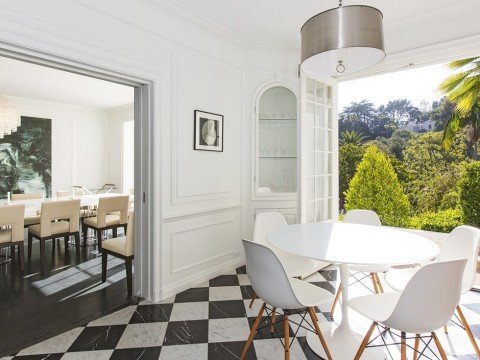By Max Mervis
Perhaps you’ve walked into an historic home and immediately sensed depth and subtle elegance surrounding you, but couldn’t put your finger on exactly what it was. Or maybe it was last summer in Paris where the hotel suite evoked timeless sophistication, yet it’s only a few years old? If that’s the case, I’ll let you in on a not-so-little secret: what you have been sensing probably isn’t just the furnishings that fill the room, but merely lengths of simple, wooden moldings tacked together on the walls, impersonating as elaborate paneling.
Although this decorating technique dates back thousands of years, today you will often find it in some of the most elaborate homes and high-end hotels. The good news? Adding picture frame moulding is a quick and relatively inexpensive way not only to add architectural interest to a room, but elevate it to new heights.
Known by a variety of monikers including picture frame molding, panel molding, skeleton molding, French molding and faux boiserie, no matter what you call it, moldings add understated complexity and depth to a room without having to fill it up with bulky furnishings or overwhelming the space with art. Although picture frame molding is in essence a classical technique, it is not limited just to traditional homes. Even the simplest, most modern of interiors can benefit from this method, resulting in a polished backdrop that balances the stronger lines of contemporary elements.
In a more traditional residence with lower ceilings, picture frame molding combined with a 6”-8” crown molding will visually heighten the ceiling. If your residence already has high ceilings, the moldings can actually warm up the room, making it feel less “warehouse-y” and more stately.
There are many different types of techniques that can be implemented when installing picture frame molding, and literally thousands of different types of moldings that can be used. The first rule of thumb is to decide how much you want your wall panels to “pop.” One of the most common and simplest designs is to use a standard 3/4” to 1.5” bead liner, available at most lumber yards. If your existing architecture can balance a more dramatic panel backdrop, there are a myriad of companies that produce historically accurate moldings with seemingly endless choices.
It’s always best to take a simpler approach to avoid your room looking too contrived or busy, but definitely have fun creating a unique, timeless look that is all your own.
Types of Wall Panels:
The Wall Frame
Popularized by the British in the 1750s, this type of molding panel is a thin, near floor-to-ceiling rectangle. The molding panels will reach from just under the crown molding to right above the baseboard. The general rule is to have 4” around each panel, and placed 4” away from any existing window and door casings.
Paneled Chair Rail
Chair rail molding is a nice touch that adds a sense of refinement and proportion to rooms, especially if you’re planning to add crown molding. The height of the chair rail according to experts should be 1/3 the total height of the wall from floor to ceiling. Therefore, with a standard 8’ ceiling, the top of your chair rail should be about 32” from the floor. For a more complete finish, add coordinating sized wall panels above the panels in the chair rail.
Wainscoting
The difference between a chair rail and a wainscoting is the height – whereas a chair rail stands approximately 32” from the floor, a wainscoting can stand 3’ to 5’ depending on your ceiling height. Commonly found in Craftsman, Tudor and Cape Cod styled homes, traditionally it is constructed from tongue-and-groove boards, bead-board or decorative panels, such as what you might find on a wooden door. The upper exposed portion of wall can be painted a contrasting color or wallpapered depending on your personal style. Either way, a wainscoting gives a clean, crisp finish to a room due to the height and is a timeless, versatile method of furnishing your walls.



